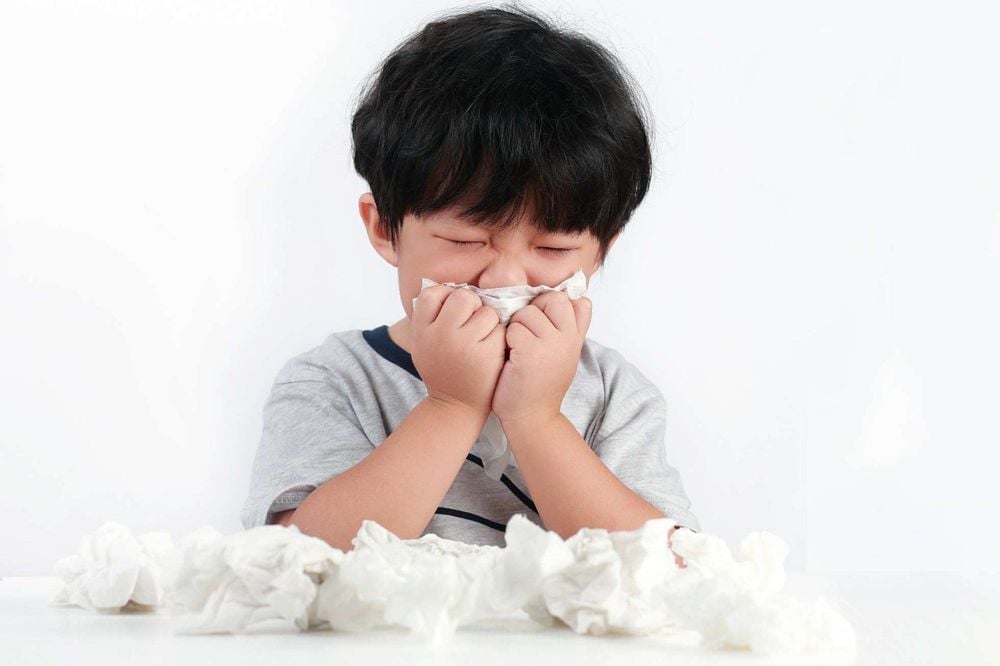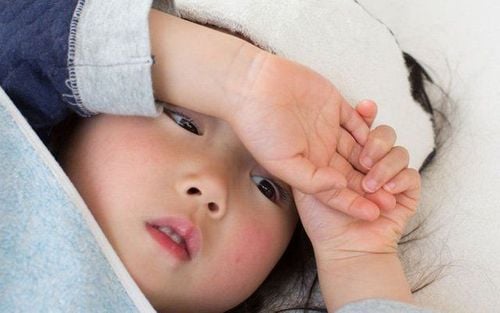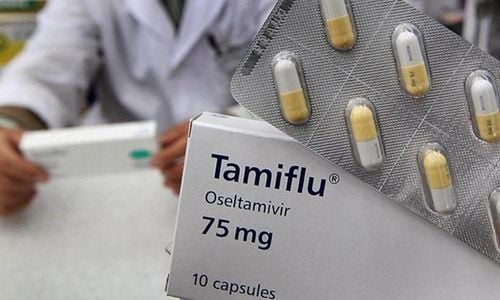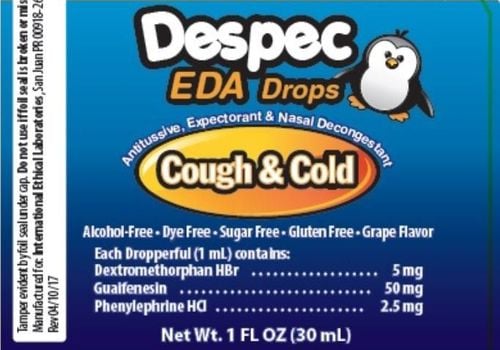This is an automatically translated article.
The average child will catch five to eight colds a year or more, if friends or siblings can spread the disease to them. When a child has the flu, it can take a long time for a child to sniffle, sneeze, and feel uncomfortable. However, there are still some misconceptions about the disease. The article will give ideas to help parents find remedies to reduce symptoms of the disease1. Myth 1: Over-the-counter cough and cold medicines in children work better
The American Academy of Pediatrics (AAP) says over-the-counter medications to relieve stuffy noses, runny noses, and coughs are not effective for children younger than 6 years old and can have harmful side effects. If a child under 6 years of age has a cough and cold or flu-related illness in their child, ease his or her symptoms with children's acetaminophen or ibuprofen and safe home remedies.For example, a previous study found that common cough syrups worked no better than the same amount of non-specialized syrups. And a 2007 study found that honey worked better than cough syrup for children 2 years of age and older.
Over-the-counter drugs can also be dangerous, especially when a child takes the wrong medicine more than the recommended dose.
In addition to side effects such as drowsiness or trouble sleeping, stomach upset, rash or hives, children can have serious effects such as rapid heart rate, convulsions and even death. Every year, 7,000 children under the age of 11 are treated in US emergency rooms after taking too much cough or cold medicine.
2. Myth 2: Antibiotics can kill germs that cause colds and flu
Treating a cold or flu with antibiotics is like using nasal drops to treat hangnail. That's because antibiotics kill bacteria, and colds and flu are caused by viruses, not bacteria.The medical staff have worked hard to dispel this notion, but it will not completely disappear. Anxious parents push the doctor to prescribe antibiotics to help their child feel better, but the truth is: No antibiotic — from Amoxil to Zithromax — will help cure a cold or flu.
Lack of effectiveness is not the only reason to avoid unnecessary antibiotics. The drug can have unpleasant side effects such as diarrhea and stomach cramps. And the bacteria that cause the disease can eventually become resistant to the drugs, making true bacterial infections harder to treat.
On the other hand, if a child develops a complication of a cold or flu involving bacteria, antibiotics may be helpful. This is the case, for example, if the child has an ear infection, bronchitis, or pneumonia.

Thuốc kháng sinh không có hiệu quả trong việc điều trị cảm lạnh và cảm cúm
3. Myth 3: There is no difference between a cold and the flu
At first, it can be difficult to tell the difference between a cold and the flu. But colds almost always go away without causing any real trouble, while the flu can lead to serious complications, such as pneumonia. Recognizing the flu early can help you get appropriate treatment and possibly prevent complications.If your child is at high risk for complications from an underlying medical condition, prompt detection of a case of the flu can open the door to treatment. If your child is 1 year old or older, he or she can receive an antiviral medication, which kills the virus that causes the flu and speeds recovery in a day or two. But antiviral drugs are only effective if taken during the first two days of illness. After the 48 hour window closes, they are no longer effective.
Here's how to distinguish a cold from the flu:
Colds often come on slowly. The first sign is usually a sore, itchy throat, followed by sneezing and a runny nose with clear mucus, which can thicken and turn gray, yellow, or green over the next week. Other common symptoms include cough, mild headache, watery eyes, mild fatigue, and stuffy nose. In contrast, the flu often hits like a truck. Symptoms come on quickly and tend to be severe. Baby feels very weak, tired and achy. Your baby may have a dry cough, runny nose, chills, sore throat, swollen glands, headache, and sore eyes. His appetite may be poor In infants and children, the flu can also cause abdominal pain, diarrhea, and vomiting. Symptoms of swine flu are the same as those of seasonal flu. If your child gets better (or slightly better) after the fever goes down, he may have a cold. If your child is sick even when the temperature drops, it's likely that he or she has the flu.
If you have trouble identifying your child's illness or are concerned about your child's symptoms, call the doctor. Sometimes children need some tests to see if they have the flu.
4. Myth 4: Take your children to the doctor when they have a cold.
Each year, 1 billion colds strike in the United States. So it's no surprise that the common cold is the number one reason people visit the doctor's office. But almost all of those visits are unnecessary because there's nothing the doctor can do to reduce the severity of a cold.If it's really a cold and it's not serious, keep the child at home. Your child may just need some time off to fight the virus. You'll likely save time, money, and reduce your risk of being exposed to more germs.
However, some children with colds need medical help. Likewise, some children with the flu develop complications that require immediate attention. And if your baby is under 3 months old, call the doctor at the first sign of any illness.

Trẻ cảm lạnh và không nghiêm trọng thì hãy giữ trẻ ở nhà
5. Myth 5: Influenza vaccination is more important for adults than children
In fact, getting a flu shot is just as important for children as it is for adults.The Centers for Disease Control and Prevention (CDC) recommends that children get a flu vaccine every year (starting at 6 months of age) for most people, from young to old, with the best time to get it in January. October or November to allow time for immunity to develop before flu season begins.
Children under the age of 5 are especially susceptible to the flu because they are at higher risk of serious flu-related complications such as pneumonia. Every year in the United States, more than 20,000 children under the age of 5 are hospitalized with the flu. The CDC also emphasizes the importance of vaccines for household contacts and caregivers of children under 5 years of age.
6. Myth 6: You can catch the flu with a flu shot
Flu shots are made from inactivated (killed) viruses. And can't get sick from a dead virus.However, in some cases it is still possible to wonder if a child has any possible side effects from the injection: low-grade fever, soreness, soreness, swelling or redness at the injection site. These symptoms may be uncomfortable, but they are a reaction to the shot, not a sign of infection.

Các mũi tiêm phòng cúm được thực hiện từ các virus đã bị bất hoạt (bị giết)
7. Myth 7: Dietary supplements such as zinc, vitamin C... can ease cold symptoms in children
Many people think that taking vitamin C at the first sign of a cold, sucking on zinc lozenges for a sore throat, or boosting immunity with echinacea all work.There is some research to support each of these remedies. But there are also a few studies that dispute their effectiveness.
Before giving your child any supplements, of any kind, talk to your doctor. Even "natural" remedies can be harmful - for example, the Chinese herb ephedra, also known as ephedra or ephedra. In adults, this herbal decongestant has been linked to high blood pressure, irregular heartbeat, seizures, heart attack, and stroke.
7.1 Zinc Studies on zinc have produced mixed results. Some people have found that zinc is just a placebo. Others report that it reduces the duration of colds.
Zinc can also have side effects. The lawsuits against the manufacturer of zinc in the form of a nasal spray, for example, allege that the product has caused permanent damage to the sense of smell. And high doses, possibly from long-term use or unintentional overdose, can be toxic.
7.2 Vitamin C Vitamin C has long been touted for its ability to fight colds. But in 2007, when researchers reviewed 30 long-term studies involving more than 11,000 adults over several decades, they found that daily doses of at least 200 mg of vitamin C did not reduce symptoms. symptoms or duration of a cold in most people.
Side effects are not usually a problem with vitamin C, although very large amounts can cause diarrhea and stomach upset. The vitamin is water-soluble, so it is not stored in the body and does not accumulate to toxic levels.
7.3 Echinacea The echinacea herb also gets mixed reviews. Some studies show no benefit, while others report a reduction in the severity and duration of a cold when it is taken in the early stages of the illness.
In one study, 524 children with colds aged 2 to 11 years had no improvement when given echinacea compared to placebo. Another study found that children who took this medicine for a cold were less likely to get colds in the months that followed. A third study concluded that the herb helped prevent or shorten the duration of colds.
Finally, a review published in 2007 with more than 700 studies concluded that echinacea reduces the risk of catching a cold by 58% and makes colds go away faster when taken shortly after symptoms appear. presently.

Liều lượng hàng ngày ít nhất 200 mg vitamin C không làm giảm các triệu chứng hoặc thời gian cảm lạnh
8. Myth 8: Children at daycare get colds more often than other children
During the first year of kindergarten, children are actually more likely to catch a cold than children kept at home.But according to a study of 135,000 children in Denmark between 1989 and 2004, the risk of infection decreased as children continued to attend daycare. And after a year in day care, a child is not at higher risk of getting sick than a child at home.
Early exposure to germs can also be beneficial in the long run. A 2002 study published in the Archives of Adolescent and Pediatric Medicine found that children who attended older preschool as preschoolers were less likely to catch colds in later years (up to age 13). Probably because they have built up immunity to most common cold viruses.
9. Myth 9: Breathing the same air as a sick person is the surest way to catch a cold
Cold viruses travel through the air, especially when an infected person coughs or sneezes. But that's just one of the ways the virus finds its next victim.Viruses can also get on your hands. If you touch something that contains a virus such as a friend's phone, toy or hand. Viruses that get on your hands can easily enter your body if you rub your eyes or nose, which are their favorite entrances. The common cold viruses can live for up to three hours on the skin or other surfaces.

Các virus cảm lạnh thông thường có thể sống trong ba giờ trên da hoặc các bề mặt khác
10. Myth 10: Being cold or wet can make you catch a cold
Only cold viruses can cause you to catch a cold. So being cold itself can't make you sick. However, cold and damp can cause a dormant virus (already in your body) to flare up, causing symptoms.In a 2005 study at Cardiff University's Joint Cold Center in Wales, 90 volunteers soaked their feet in ice water for 20 minutes. Over the next five days, the refrigerated group had twice as many colds as the control group of 90 volunteers whose feet were not chilled.
Researchers think freezing causes blood vessels in the nose to constrict, shutting off the warm blood supply to infection-fighting white blood cells. They explain that many people are carrying cold germs, but chilling can make it harder to fight its effects.
11. Myth 11: If you have a cold, it means your immune system is weak
Perfectly healthy people do not succumb to cold viruses. In one study, about 95% of volunteers became infected with a cold virus when the virus was dropped into their nose. However, not everyone infected with the virus actually gets a cold. About 75% of infected volunteers showed symptoms.Some studies show that lower immunity (eg, due to chronic illness or stress) can make cold symptoms worse. But a healthy child can easily become infected with one of at least 200 different viruses that cause the common cold.

Những người hoàn toàn khỏe mạnh không chống chọi được với virus cảm lạnh
12. Myth 12: Drinking milk makes the body secrete more sebum
Several studies have tracked the milk consumption of adults infected with cold viruses. They found no link between dairy consumption and mucus production or any other cold symptoms for that matter.In another study, researchers found that among those studied who had coughs, those who drank more milk experienced "more fluid" coughs.
Colds and flu are often confused with each other. These two diseases have completely different treatment methods, so when you have questionable symptoms, you should not buy oral drugs on your own, but go to a medical facility to examine and use drugs as prescribed by your doctor. Vinmec International General Hospital is a high-quality medical facility in Vietnam with a team of highly qualified medical professionals, well-trained, domestic and foreign, and experienced.
In addition, in order to prevent diseases that babies often get, parents should pay attention to nutrition to improve children's resistance. At the same time, add supporting foods containing lysine, essential micro-minerals and vitamins such as zinc, chromium, selenium, B vitamins,... snacks and less digestive problems.
Parents can learn more:
Why do you need to supplement Lysine for your baby?
The role of zinc - Guidelines for reasonable zinc supplementation
Please visit the website Vinmec.com regularly and update useful information to take care of your baby and family.
Reference source: babycenter.com













